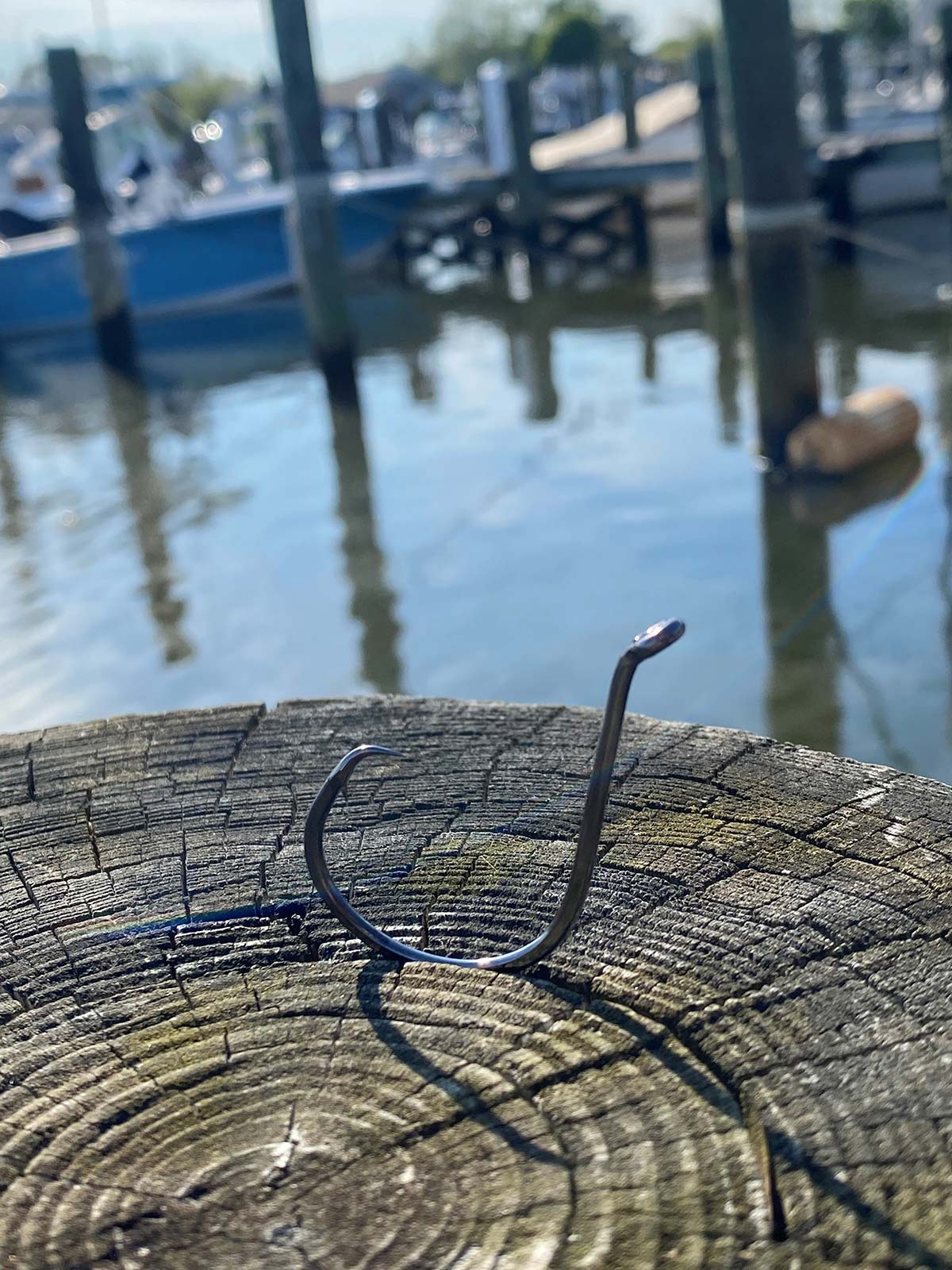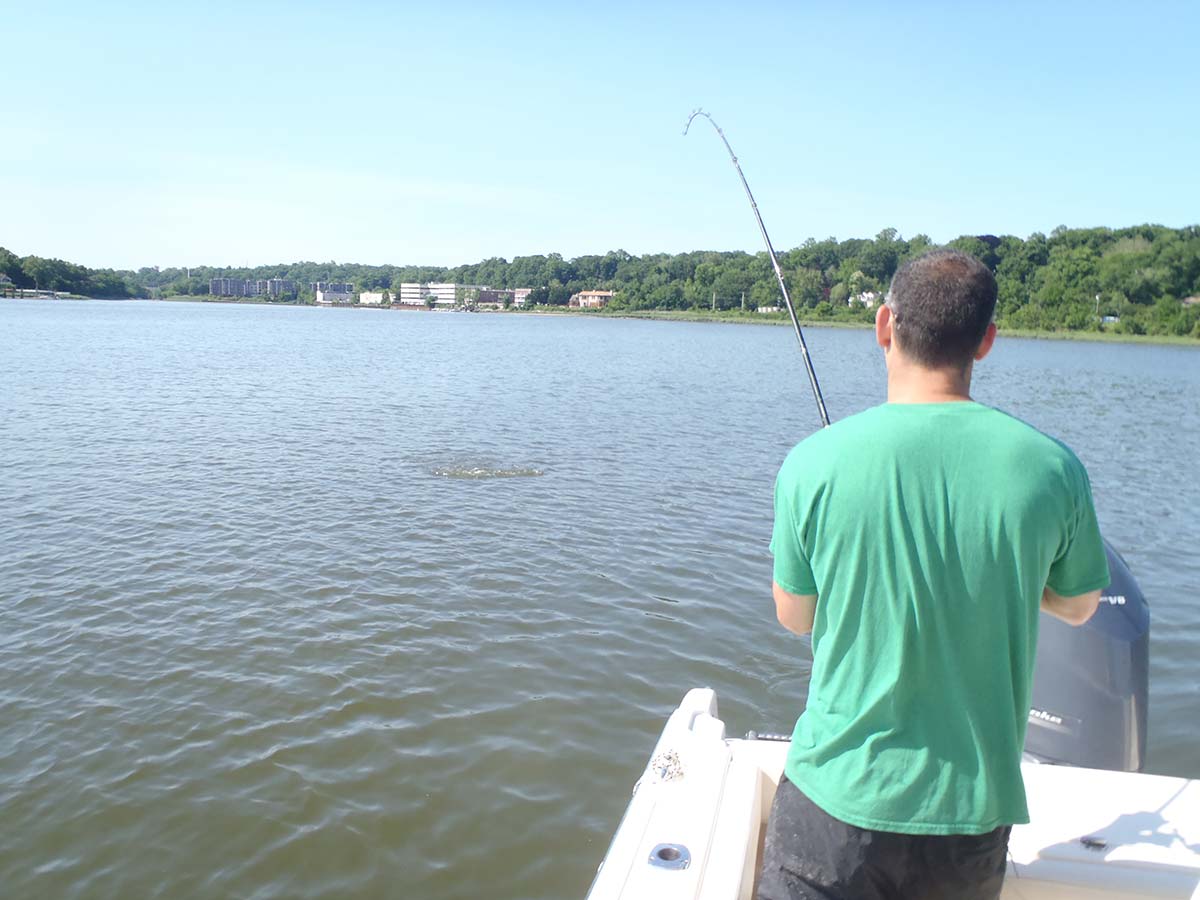
Overcome the livelining learning curve.
Although livelining for striped bass has waned a bit over the last ten years in the western Sound, 2022 was a pleasant surprise. Don’t misunderstand me; large stripers have been taken livelining each spring. In general, to succeed with regularity, an angler needed to be a seasoned pro. However, in 2022, May, June, and even early July exceeded everyone’s expectations.
Improved Opportunities
| HOOKING BUNKER |
| Rich and Marc are very fussy about where they hook the bunker. They place it in the back behind the dorsal fin. They have found that placing it there did the least harm to the fish’s vigor and extended its life. I’ve fished with others who run the hook through the nostrils, in front of the tail, or through the lips. They all work, and I think the best hooking technique depends on water depth and current. For example, a bunker hooked behind the dorsal and fished in a current will not swim right. However, in the shallow calm harbors, Lazar’s approach works great. |
Perhaps the slot size regulations helped, maybe it was the abundance of adult bunker, or it simply could have been a matter of Hudson River post-spawn stripers remaining in western harbors instead of making a beeline east and north. Whatever the reason, improved livelining for stripers was a most pleasant surprise. I also must be honest that in recent years, because the fishing was slow, I’d been reluctant to accept my friend Rich Lazar’s invitations. Although Rich and his son Marc are experts at livelining, doing so many times a week, and have been doing it for many springs, I’m the neophyte on the boat. I don’t see what they see, understand what they understand, or know the subtleties of influences that entice a striper to attack a live bunker.
I may be reluctant to push myself when fishing is slow, but I’m no dummy either. So, when Rich reported constant livelining action, I saluted, said, “I’ll be there,” and showed up on time the following day. That next morning, it was calm and easy to spot a number of bunker schools flipping in the angled early sunlight. It was of no concern to me that the bunker seemed unthreatened because, except for rare moments, stripers don’t typically harass bunker schools and make them flush the way blues seem to always do.
Getting Bait
The first order of business in livelining is to secure bait. Many anglers snag the bunker, but Rich prefers to net them. Indeed, over the years, I’ve noticed the difference in effectiveness between snagged and netted bunker. First of all, if you snag a bunker in the gills, in the head near the brain, or rip open the belly, their life expectancy is short. In addition, although you might expect a striper to key in on less lively bunker, that isn’t generally the case when livelining in shallow water.
Clearly, lively bunker outproduce weak and dying bunker. Perhaps this is because in shallow harbors, the stripers stage in certain spots away from the bunker schools and must be triggered to eat, or maybe it’s because of some instinct that makes them equate lively with healthy and full of calories. Who knows? This is all conjecture. What matters is that regulars to the technique, like Rich and Marc, know where the staging areas are, know the right stages of the tide to work those areas, and have fine-tuned their interpretation of striper behavior.
Netting is a better choice, and Marc is our net man, while Rich works the boat into position and then turns in a circle at the right moment to create turbulence and noise that prevents the bunker from escaping away from the net. It’s crucial not to put too many baits in the livewell because congestion will weaken the bunker, and they will die prematurely. Rich keeps about a dozen or so at a time, depending on the water temperature: cold water allows him to keep more, warm water less.
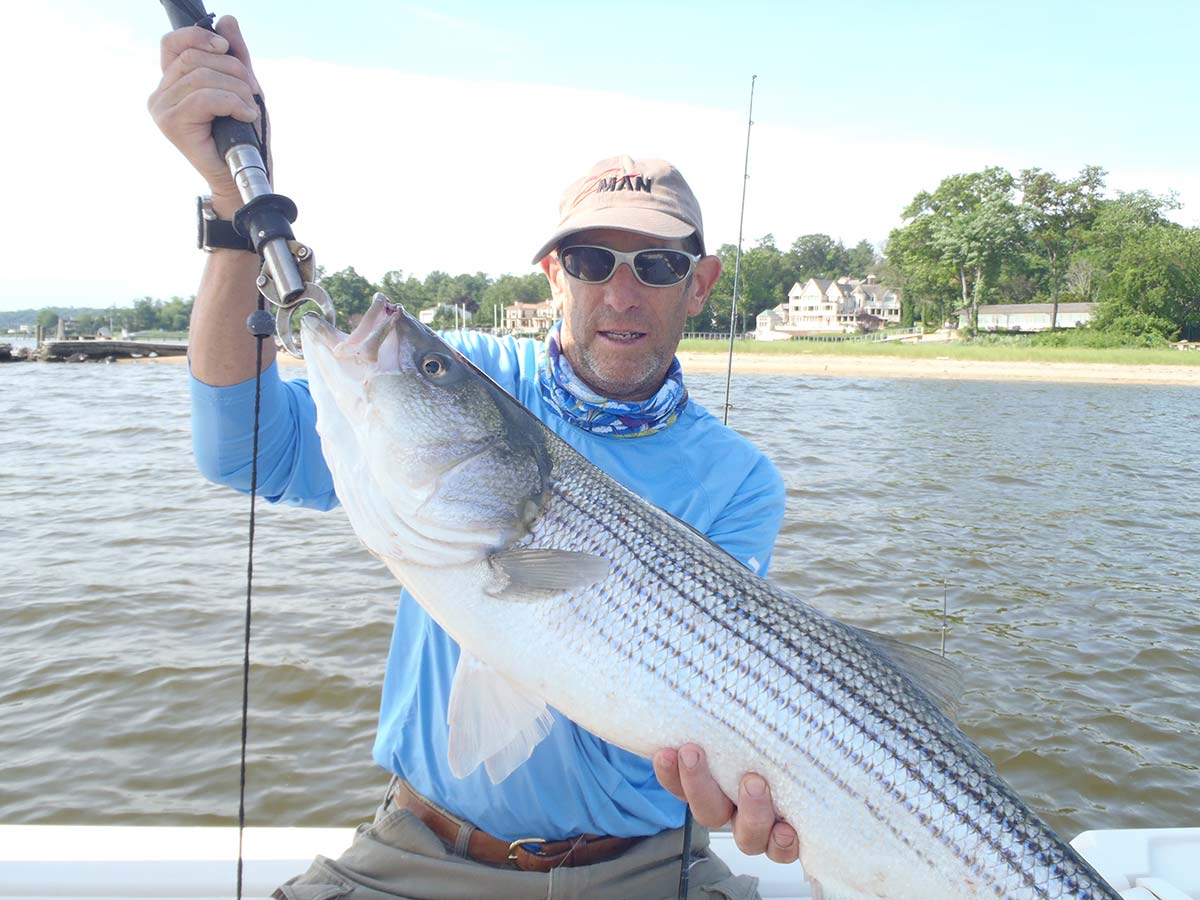
When You Think You Got It
Over the years, the formula has been learned and practiced. Start with a live bunker, netted, not snagged, mix in an understanding of local tide stages, add some good livelining tackle, stir in the proper number of vigorous bunker in the live well, and then add a dash of knowledge of local staging areas. Blend together carefully for good live-lining success.
Finding a few staging areas takes some searching. Staging areas tend to be along the shoreline in minor depressions, amongst scattered boulders, or sometimes around docks. However, there is a fundamental rule when it comes to fishing: there are no absolutes, so one day’s staging area is tomorrow’s void.
Just when you think you’ve got it all figured out, Nature throws a curve ball. With bunker in the well, Rich slowly pushed the boat into the middle of the harbor and into the channel. Since I’ve also learned where the staging areas are, I was surprised by this and said, “What’s up? Where are we going?” Rich responded, “We first tried a few of the usual staging areas yesterday but didn’t have any players, so we moved out here on a whim and found the fish waiting and eager.” Being able to adapt to changes in Mother Nature’s recipes is a very important trait for any angler to have, so Rich didn’t need to say another word.
Almost Blitz-Like
Frankly, I was expecting more typical sedate livelining action. That is, put out a few live ones, manage them, and wait. Not this time. I was still fishing around in my bag to get my camera ready when I heard that unmistakable sound of a striper sucking in a bunker. I turned my head in time to see Marc’s rod bent solid into a good fish. Rich and Marc have always been good stewards of our fisheries, and they continue that ethic by using only circle hooks. I got a lecture about this that began at the dock and continued until we anchored.
“Remember,” Marc said, “don’t set the hook. Just reel tight, and the hook will set itself.” Of course, I already knew this, but I discovered consistently putting it into practice wasn’t going to be automatic. So, I set the hook on my first running fish and of course, dropped it. I was excited, made a rookie mistake, but quickly got into the rhythm of things.
Was this a single fish? Before Marc had his fish halfway to the boat, Rich was into a fish and calling for me to come take the rod. I declined, saying, “I’ll hook my own fish.” As fast as a fish was boated, carefully released, and a fresh bunker set out to meet its fate, a striper would be on it, driving it to the surface, down to the bottom, and fast away from the boat. At times a striper would slap the bunker three feet in the air, and at other times the fish would seem to torment the bunker by swirling around it before taking it down in one gulp. This was near-blitz-like fishing on mid to upper-teen stripers.
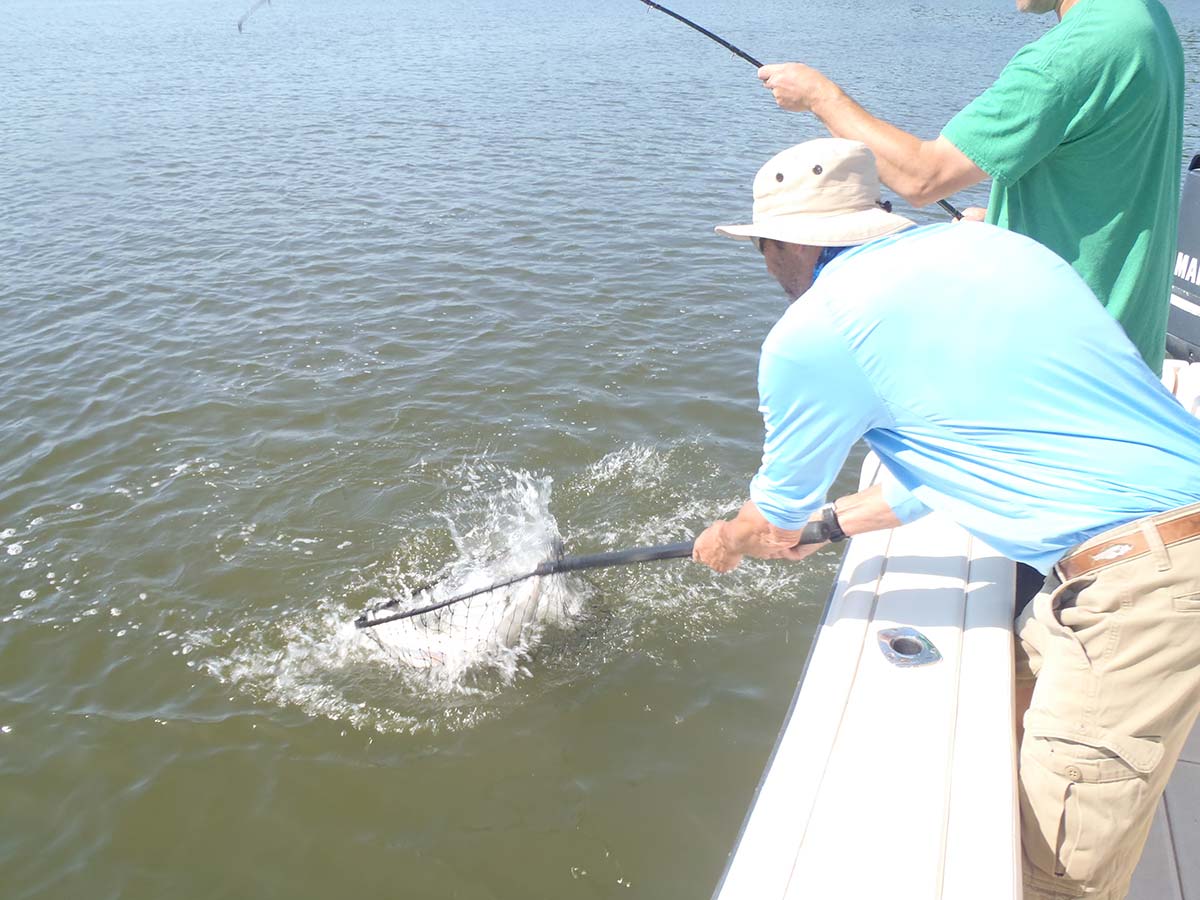
Just Chunk It
Another good trait for a serious angler to have is curiosity. A willingness to test out inspirations while in the process of catching fish can produce dramatically improved results. It was going to be hard to improve on this outing, and we knew a change in approach could also bite you; well, you know where, but overall, it’s a good trait to have. I do this in the surf all the time. I may be catching a lot of little fish, but I look around and see something that tweak’s my interest. Perhaps, I think, there are bigger fish over there. Sometimes you get the bear, and sometimes the bear gets you, as the saying goes.
Anyway, we decided to see what might happen if we put a chunk out on the bottom, right behind the boat. The thinking was that this could go two ways. Maybe, larger fish were in the area but were out-competed by more aggressive teen-size stripers. So, while the teenagers chased and taunted the bunker, maybe a cow might suck in a chunk away from the fray. Well, we weren’t punished by this ploy, but it didn’t really work either. We did catch a few fish on chunks, but they were the same teen-sized fish we caught with the live bunker, so we gave up on the chunks and stuck to livelining.
Livelining Tackle
Although their tackle is stout, none of their rods could be called “meat sticks.” They have backbone, but the tips are soft enough to prevent ripping a hook through and out of a bunker while managing it. Also, the runs of even teen stripers are significant, and a softer tip saves fish that are lightly hooked from ripping loose. Their gear is an excellent blend that allows an angler to enjoy an outstanding fight, yet strong enough to manage stripers well and bring them to the net before they are exhausted.
They use a variety of conventional reels, but almost all of them have a level wind feature that makes it unnecessary to guide the line back and forth manually while reeling in to prevent it from bunching in one spot. Conventional reels are important because of the need to manage the bunker. Managing bunker properly is a skill. The wrong move can turn a lurking striper off fast, while the right move can trigger a take.
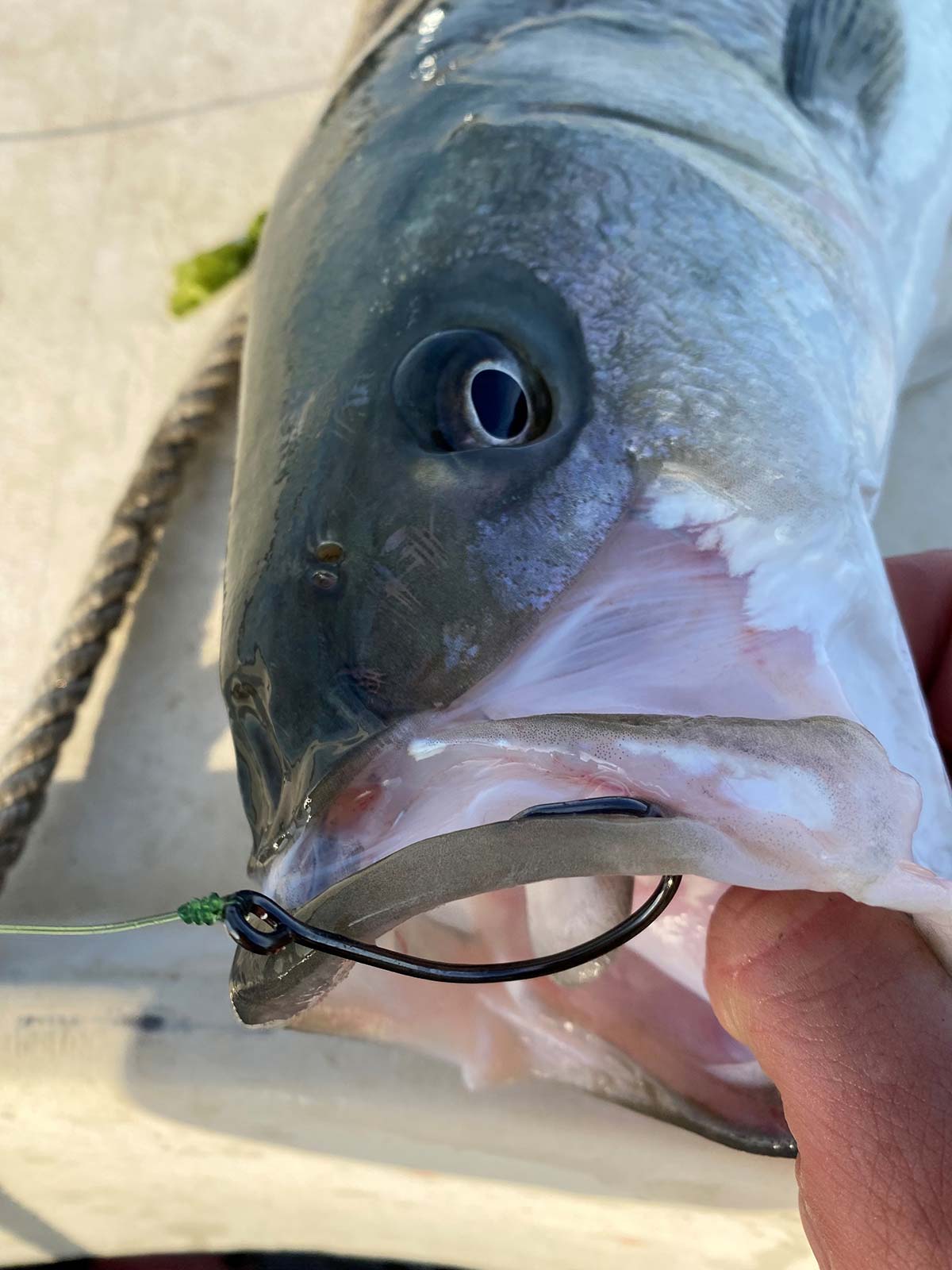
Managing Bunker
| FOLLOWING THE LAW |
| In an effort to help lower the mortality rate of hooked and released stripers, law was put into effect that when bait fishing for striped bass with natural baits (menhaden, clam, live eel, etc.) you much use an inline circle hook when doing so. This means even if you do snag a bunker with a treble, you must reel in that bait and switch it over to a circle immediately before targeting a striper.
|
For some reason, year after year, the bunker I select seem to like me too much because as soon as I toss them gently away from the boat, they make a beeline back to me. It is difficult to catch a striper with a bunker that’s hunkered down right next to the gunwale. However, Rich and Marc’s bunkers seem to love moving away from the boat, much to my frustration. We have a good laugh or two about this, but seriously, it happens to me a lot. The Lazars watch the bunker intently and can read subtle behavior changes quickly and pick up the rod and begin management. Sometimes, they pull the bunker toward the boat gently, sometimes they let it run away a bit, and sometimes they coax it to circle back towards the boat.
Whatever they do and however they do it, it works. It starts when one of them says, “I’ve got a player.” A player is a striper that’s near to and interested in the bunker. At first, the bunker’s behavior is subtle, but then the bait begins to turn fast and swim with panic. If the striper loses interest, they begin to make the bunker move differently, and that usually rekindles interest, but there is a point when they stop managing the bait, and that’s the point when the striper is about to engulf the bait. Frankly, they see it, but I rarely do. I’m lucky if I can notice the difference between a bunker being chased and one that’s just gone bonkers.
In the end, I love it when the action is this good, and my lack of experience doesn’t matter as a whole because the fish are so very eager. It’s visual, it’s skillful, it’s exciting, and the fish are big. The techniques may take a little time to master, but once practiced, it’s a ton of fun.
